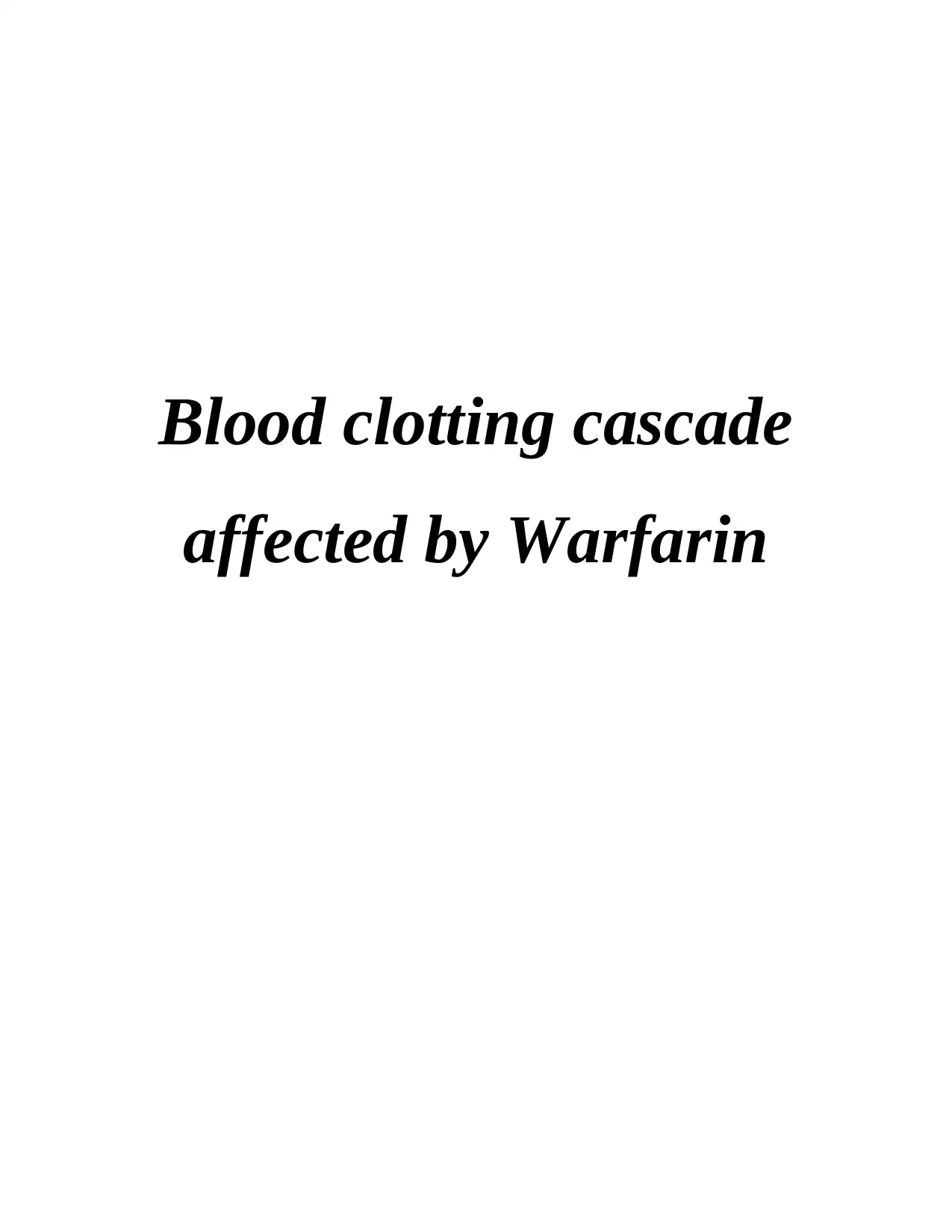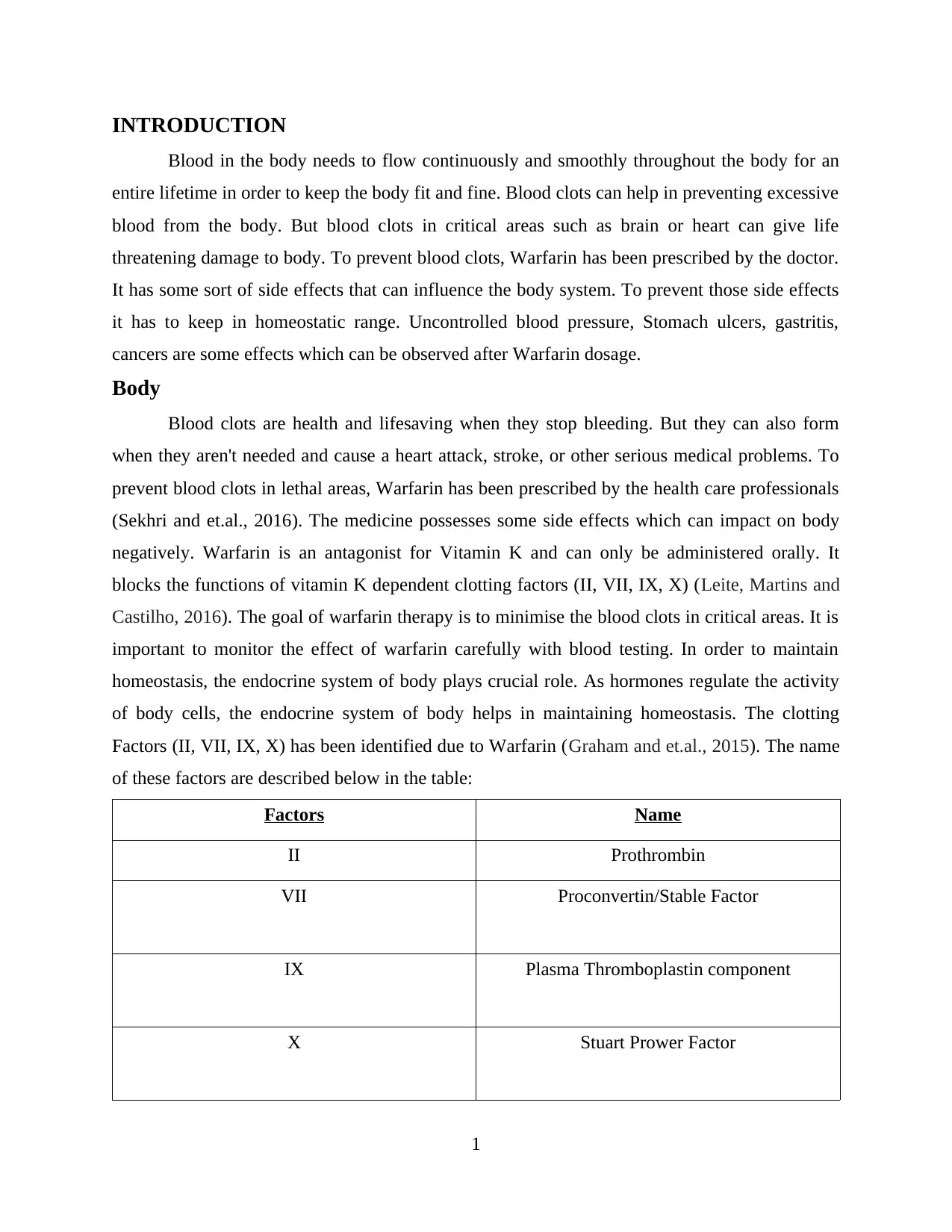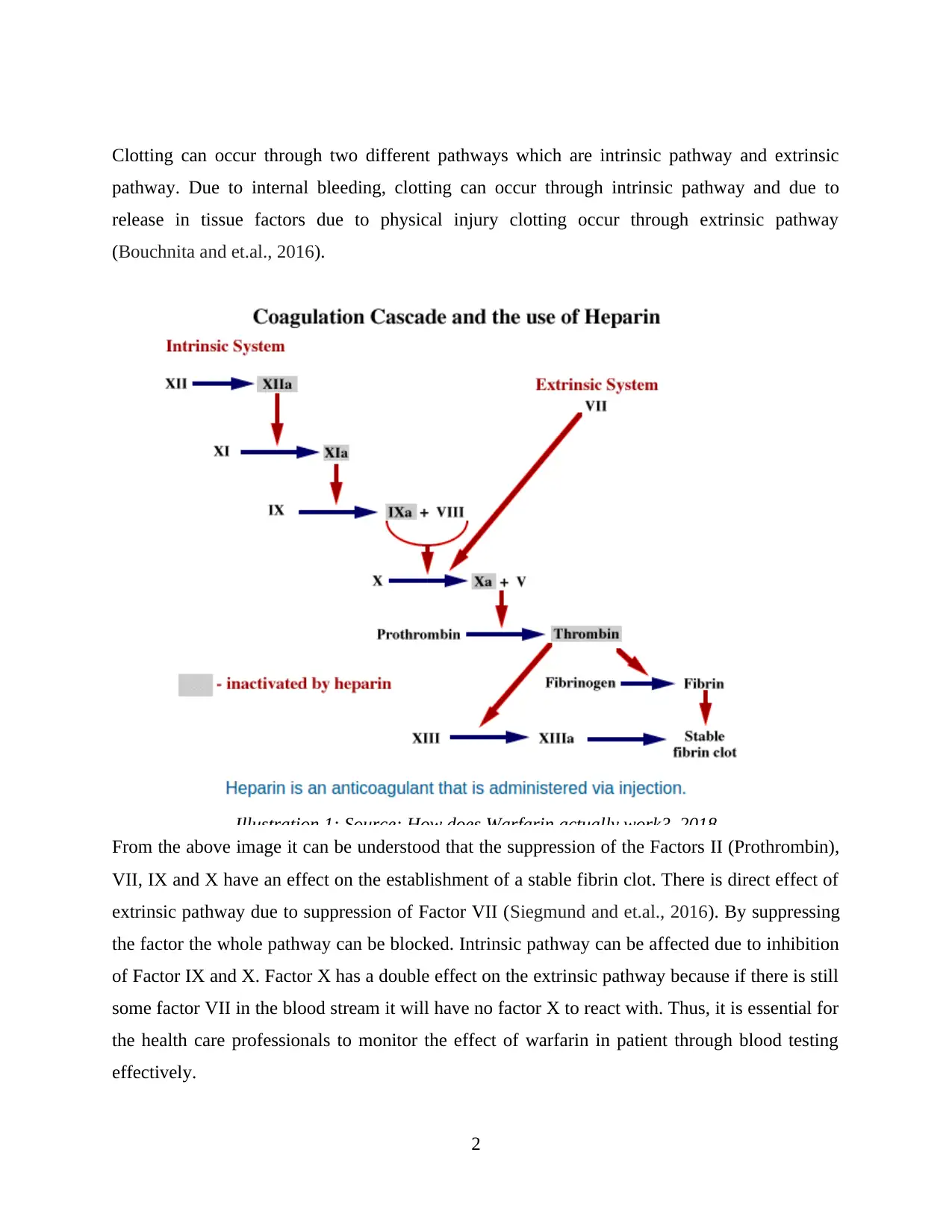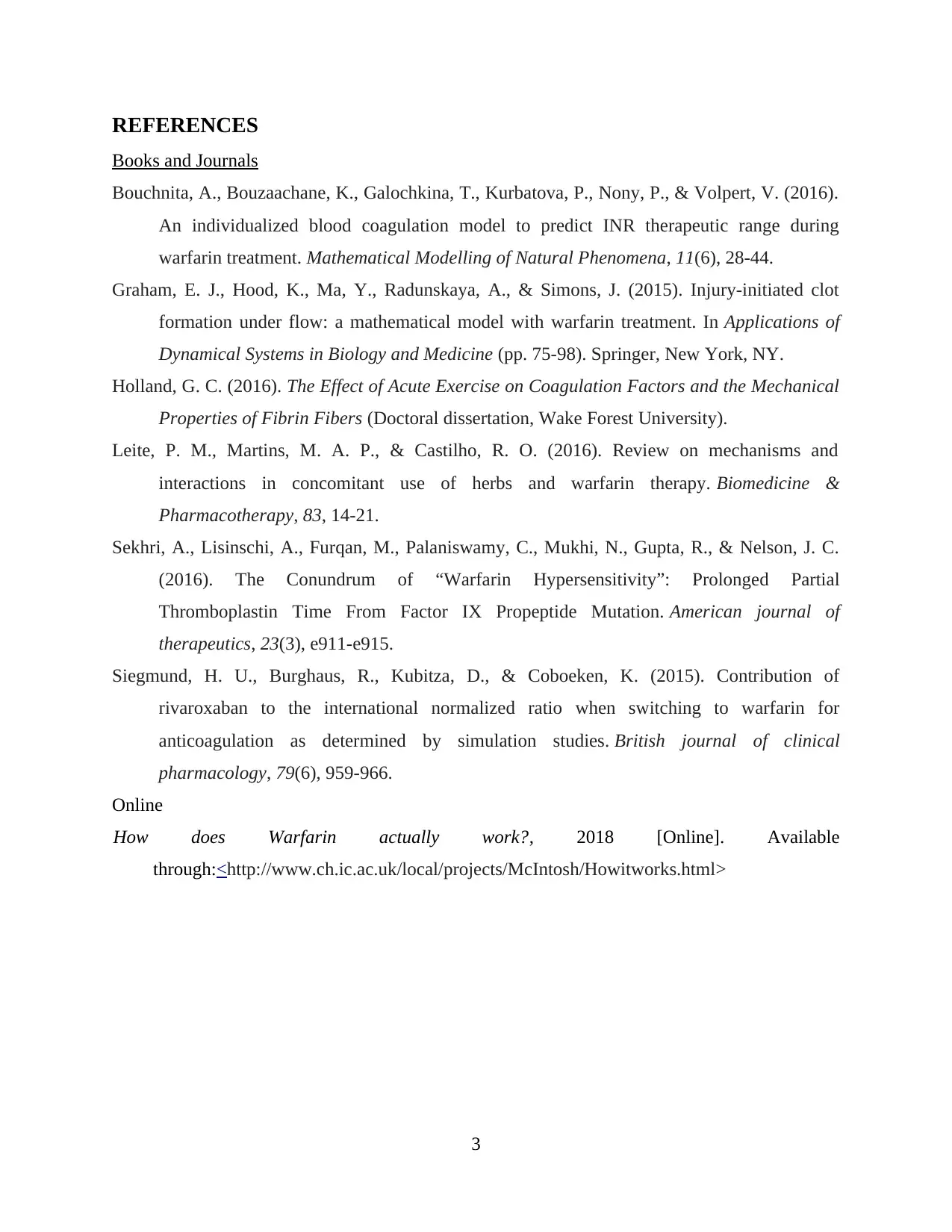Detailed Analysis: Warfarin's Impact on Blood Clotting Cascade
VerifiedAdded on 2020/06/06
|5
|921
|108
Report
AI Summary
This report provides a detailed analysis of Warfarin's impact on the blood clotting cascade. It begins with an introduction to the importance of blood clotting and the role of Warfarin in preventing clots, particularly in critical areas. The report then delves into the mechanism of Warfarin, highlighting its function as a Vitamin K antagonist and its effects on clotting factors II, VII, IX, and X. The report explains the intrinsic and extrinsic pathways of blood clotting and how Warfarin suppresses these pathways. Additionally, the report emphasizes the importance of monitoring Warfarin therapy through blood testing to maintain homeostasis. The report includes a table summarizing the clotting factors affected by Warfarin and concludes with references to relevant books, journals, and online resources. The report also references an illustration depicting Warfarin's mechanism of action.

Blood clotting cascade
affected by Warfarin
affected by Warfarin
Paraphrase This Document
Need a fresh take? Get an instant paraphrase of this document with our AI Paraphraser

Table of Contents
INTRODUCTION...........................................................................................................................1
Body.................................................................................................................................................1
REFERENCES................................................................................................................................3
INTRODUCTION...........................................................................................................................1
Body.................................................................................................................................................1
REFERENCES................................................................................................................................3

INTRODUCTION
Blood in the body needs to flow continuously and smoothly throughout the body for an
entire lifetime in order to keep the body fit and fine. Blood clots can help in preventing excessive
blood from the body. But blood clots in critical areas such as brain or heart can give life
threatening damage to body. To prevent blood clots, Warfarin has been prescribed by the doctor.
It has some sort of side effects that can influence the body system. To prevent those side effects
it has to keep in homeostatic range. Uncontrolled blood pressure, Stomach ulcers, gastritis,
cancers are some effects which can be observed after Warfarin dosage.
Body
Blood clots are health and lifesaving when they stop bleeding. But they can also form
when they aren't needed and cause a heart attack, stroke, or other serious medical problems. To
prevent blood clots in lethal areas, Warfarin has been prescribed by the health care professionals
(Sekhri and et.al., 2016). The medicine possesses some side effects which can impact on body
negatively. Warfarin is an antagonist for Vitamin K and can only be administered orally. It
blocks the functions of vitamin K dependent clotting factors (II, VII, IX, X) (Leite, Martins and
Castilho, 2016). The goal of warfarin therapy is to minimise the blood clots in critical areas. It is
important to monitor the effect of warfarin carefully with blood testing. In order to maintain
homeostasis, the endocrine system of body plays crucial role. As hormones regulate the activity
of body cells, the endocrine system of body helps in maintaining homeostasis. The clotting
Factors (II, VII, IX, X) has been identified due to Warfarin (Graham and et.al., 2015). The name
of these factors are described below in the table:
Factors Name
II Prothrombin
VII Proconvertin/Stable Factor
IX Plasma Thromboplastin component
X Stuart Prower Factor
1
Blood in the body needs to flow continuously and smoothly throughout the body for an
entire lifetime in order to keep the body fit and fine. Blood clots can help in preventing excessive
blood from the body. But blood clots in critical areas such as brain or heart can give life
threatening damage to body. To prevent blood clots, Warfarin has been prescribed by the doctor.
It has some sort of side effects that can influence the body system. To prevent those side effects
it has to keep in homeostatic range. Uncontrolled blood pressure, Stomach ulcers, gastritis,
cancers are some effects which can be observed after Warfarin dosage.
Body
Blood clots are health and lifesaving when they stop bleeding. But they can also form
when they aren't needed and cause a heart attack, stroke, or other serious medical problems. To
prevent blood clots in lethal areas, Warfarin has been prescribed by the health care professionals
(Sekhri and et.al., 2016). The medicine possesses some side effects which can impact on body
negatively. Warfarin is an antagonist for Vitamin K and can only be administered orally. It
blocks the functions of vitamin K dependent clotting factors (II, VII, IX, X) (Leite, Martins and
Castilho, 2016). The goal of warfarin therapy is to minimise the blood clots in critical areas. It is
important to monitor the effect of warfarin carefully with blood testing. In order to maintain
homeostasis, the endocrine system of body plays crucial role. As hormones regulate the activity
of body cells, the endocrine system of body helps in maintaining homeostasis. The clotting
Factors (II, VII, IX, X) has been identified due to Warfarin (Graham and et.al., 2015). The name
of these factors are described below in the table:
Factors Name
II Prothrombin
VII Proconvertin/Stable Factor
IX Plasma Thromboplastin component
X Stuart Prower Factor
1
⊘ This is a preview!⊘
Do you want full access?
Subscribe today to unlock all pages.

Trusted by 1+ million students worldwide

Clotting can occur through two different pathways which are intrinsic pathway and extrinsic
pathway. Due to internal bleeding, clotting can occur through intrinsic pathway and due to
release in tissue factors due to physical injury clotting occur through extrinsic pathway
(Bouchnita and et.al., 2016).
From the above image it can be understood that the suppression of the Factors II (Prothrombin),
VII, IX and X have an effect on the establishment of a stable fibrin clot. There is direct effect of
extrinsic pathway due to suppression of Factor VII (Siegmund and et.al., 2016). By suppressing
the factor the whole pathway can be blocked. Intrinsic pathway can be affected due to inhibition
of Factor IX and X. Factor X has a double effect on the extrinsic pathway because if there is still
some factor VII in the blood stream it will have no factor X to react with. Thus, it is essential for
the health care professionals to monitor the effect of warfarin in patient through blood testing
effectively.
2
Illustration 1: Source: How does Warfarin actually work?, 2018
pathway. Due to internal bleeding, clotting can occur through intrinsic pathway and due to
release in tissue factors due to physical injury clotting occur through extrinsic pathway
(Bouchnita and et.al., 2016).
From the above image it can be understood that the suppression of the Factors II (Prothrombin),
VII, IX and X have an effect on the establishment of a stable fibrin clot. There is direct effect of
extrinsic pathway due to suppression of Factor VII (Siegmund and et.al., 2016). By suppressing
the factor the whole pathway can be blocked. Intrinsic pathway can be affected due to inhibition
of Factor IX and X. Factor X has a double effect on the extrinsic pathway because if there is still
some factor VII in the blood stream it will have no factor X to react with. Thus, it is essential for
the health care professionals to monitor the effect of warfarin in patient through blood testing
effectively.
2
Illustration 1: Source: How does Warfarin actually work?, 2018
Paraphrase This Document
Need a fresh take? Get an instant paraphrase of this document with our AI Paraphraser

REFERENCES
Books and Journals
Bouchnita, A., Bouzaachane, K., Galochkina, T., Kurbatova, P., Nony, P., & Volpert, V. (2016).
An individualized blood coagulation model to predict INR therapeutic range during
warfarin treatment. Mathematical Modelling of Natural Phenomena, 11(6), 28-44.
Graham, E. J., Hood, K., Ma, Y., Radunskaya, A., & Simons, J. (2015). Injury-initiated clot
formation under flow: a mathematical model with warfarin treatment. In Applications of
Dynamical Systems in Biology and Medicine (pp. 75-98). Springer, New York, NY.
Holland, G. C. (2016). The Effect of Acute Exercise on Coagulation Factors and the Mechanical
Properties of Fibrin Fibers (Doctoral dissertation, Wake Forest University).
Leite, P. M., Martins, M. A. P., & Castilho, R. O. (2016). Review on mechanisms and
interactions in concomitant use of herbs and warfarin therapy. Biomedicine &
Pharmacotherapy, 83, 14-21.
Sekhri, A., Lisinschi, A., Furqan, M., Palaniswamy, C., Mukhi, N., Gupta, R., & Nelson, J. C.
(2016). The Conundrum of “Warfarin Hypersensitivity”: Prolonged Partial
Thromboplastin Time From Factor IX Propeptide Mutation. American journal of
therapeutics, 23(3), e911-e915.
Siegmund, H. U., Burghaus, R., Kubitza, D., & Coboeken, K. (2015). Contribution of
rivaroxaban to the international normalized ratio when switching to warfarin for
anticoagulation as determined by simulation studies. British journal of clinical
pharmacology, 79(6), 959-966.
Online
How does Warfarin actually work?, 2018 [Online]. Available
through:<http://www.ch.ic.ac.uk/local/projects/McIntosh/Howitworks.html>
3
Books and Journals
Bouchnita, A., Bouzaachane, K., Galochkina, T., Kurbatova, P., Nony, P., & Volpert, V. (2016).
An individualized blood coagulation model to predict INR therapeutic range during
warfarin treatment. Mathematical Modelling of Natural Phenomena, 11(6), 28-44.
Graham, E. J., Hood, K., Ma, Y., Radunskaya, A., & Simons, J. (2015). Injury-initiated clot
formation under flow: a mathematical model with warfarin treatment. In Applications of
Dynamical Systems in Biology and Medicine (pp. 75-98). Springer, New York, NY.
Holland, G. C. (2016). The Effect of Acute Exercise on Coagulation Factors and the Mechanical
Properties of Fibrin Fibers (Doctoral dissertation, Wake Forest University).
Leite, P. M., Martins, M. A. P., & Castilho, R. O. (2016). Review on mechanisms and
interactions in concomitant use of herbs and warfarin therapy. Biomedicine &
Pharmacotherapy, 83, 14-21.
Sekhri, A., Lisinschi, A., Furqan, M., Palaniswamy, C., Mukhi, N., Gupta, R., & Nelson, J. C.
(2016). The Conundrum of “Warfarin Hypersensitivity”: Prolonged Partial
Thromboplastin Time From Factor IX Propeptide Mutation. American journal of
therapeutics, 23(3), e911-e915.
Siegmund, H. U., Burghaus, R., Kubitza, D., & Coboeken, K. (2015). Contribution of
rivaroxaban to the international normalized ratio when switching to warfarin for
anticoagulation as determined by simulation studies. British journal of clinical
pharmacology, 79(6), 959-966.
Online
How does Warfarin actually work?, 2018 [Online]. Available
through:<http://www.ch.ic.ac.uk/local/projects/McIntosh/Howitworks.html>
3
1 out of 5
Related Documents
Your All-in-One AI-Powered Toolkit for Academic Success.
+13062052269
info@desklib.com
Available 24*7 on WhatsApp / Email
![[object Object]](/_next/static/media/star-bottom.7253800d.svg)
Unlock your academic potential
Copyright © 2020–2025 A2Z Services. All Rights Reserved. Developed and managed by ZUCOL.





